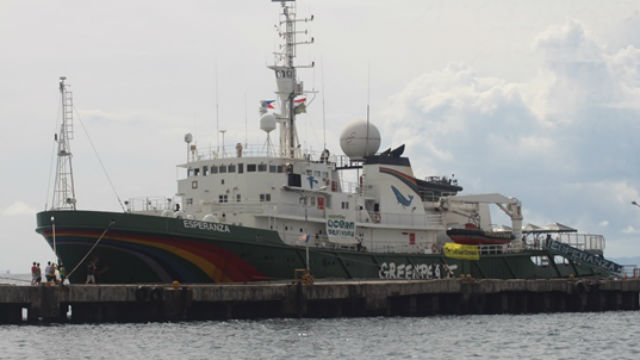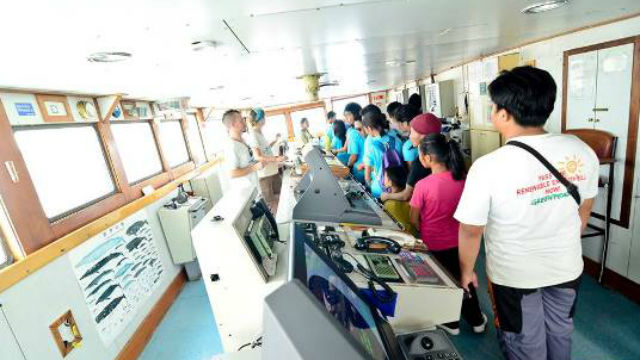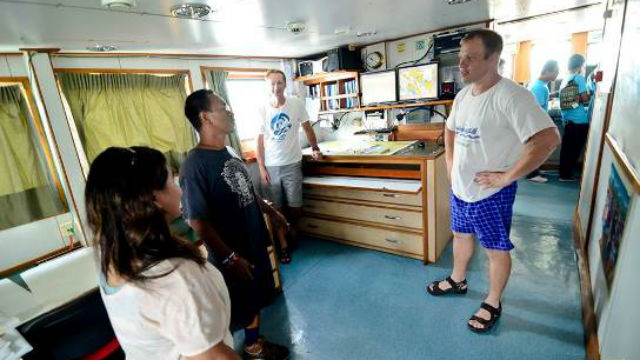SUMMARY
This is AI generated summarization, which may have errors. For context, always refer to the full article.

DUMAGUETE CITY, Philippines – Independent global campaigning organization Greenpeace’s largest ocean vessel, M/Y Esperanza, docked in Berth 6 of Dumaguete port last Friday morning, July 12.
The ex-Russian Navy firefighting ship was refitted into an environmental activism vessel in 2002. The vessel went through a series of modifications to ensure that it is environment-friendly and sustainable.
Modifications included the removal or safe containment of all asbestos, fitting a special fuel system to avoid spillage, TBT-free hull paint, and an environmentally and economically efficient propulsion system to reduce CO2 emissions.
This ship serves as home, office, workshop and platform for actions for activists, sailors, scientists, journalists, and campaigners. It also serves as a symbol for people to take action and help out with the recovery of the oceans.
The vessel opened its decks for public viewing on Saturday, July 13.
A tour to save the seas

The Ocean Defender Tour 2013 tells the story of the richness and the beauty of the Philippine seas, expose destruction that causes marine degradation and sound the alarm to call for urgent government action to save the Philippine seas from crisis.
Its first stop in the Philippines was Apo Island, a marine sanctuary in Dauin, Negros Oriental. A team of divers from Greenpeace, Siliman University Institute for Environmental and Marine Sciences (SU-IEMS) and Coastal Conservation Education Foundation (CCEF) along with some volunteers did a reef check on the island.
The divers discovered that the island lost 99% percent of its coral reefs due to a typhoon in 2011. In efforts of coral recruitment and complexity restoration, the diving team installed modules for reef builders to accumulate and provide fishes with temporary shelters.
Dr Aileen Maypa of CCEF said that this is one of the many steps Greenpeace and other organizations are doing for ocean recovery. “It is important to rebuild the habitat because we all know that if the habitat is gone, the fishes will be gone,” she added.
The divers’ next stop was Dumaguete where M/Y Esperanza was opened for public viewing. During the ship’s stay in the port of the city, Greenpeace also held a forum on climate change mitigation and connectivity of the ocean to other environmental issues.
Oceans Campaigner Vince Cinches reiterated the importance of the ocean.
“The ocean is always at the back of people’s head. In fact, ginagawa nga ng marami na basurahan (many throw garbage there) but now, after bringing a lot of stakeholders into the mix, the ingredients are complete for us to push for solutions and start the discussion in policy making that will soon change,” she maintained.
The organization’s Philippine leg prioritized issues on climate change, overfishing, and pollution both on local level and national level. The next stop will be Donsol, Sorsogon to be followed by Manila, where they will invite President Benigno Aquino III aboard.
Lone Filipino

44-year old Frederick Ventura Bangad is the only Filipino crew aboard the Ocean Defender Tour. Eric, as other crew members call him, started volunteering for Greenpeace back in 2004.
Although he returned to working for commercial ships for some time, an incident in Japan between a Greenpeace vessel and an illegal fishing vessel inspired him to join the organization.
When asked of his greatest achievement as a member, he timidly smiled. A dialogue with a famous arctic scientist, he said, may not be such a big deal for others, but being able to discuss the effects of carbon emission in China and its possible effects to the storm formation in the Philippines was contributory enough.
He said it is one of his most memorable experiences while working for Greenpeace. He added that people don’t need to do big things to be an Ocean Defender. Sometimes being sensitive enough to care about the issues is all it takes to change things for the better, he said.
Bangad said that being an Ocean Defender can mean a lot of things. An individual can do small steps such as proper solid waste management to keep garbage from reaching the oceans or help in lobbying and organizing events to push for strong policies to help protect marine resources.
Protecting the Philippine seas is the responsibility of every Filipino since many industries depend on the ocean. The campaign aims to get at least one million Filipinos to become Ocean Defenders so that the recovery of the Philippine seas would be attainable. –Rappler.com
Therene Quijano is a Rappler Ambassador from Dumaguete.
Add a comment
How does this make you feel?
There are no comments yet. Add your comment to start the conversation.